Code Blue
Our republic is in cardiac arrest. Only extraordinary measures can save us now: It's time to build a powerful new coalition party that can save our republic.
Hello Readers, Over the past four months, I’ve spent a lot of time in deep reflection on our deteriorating republic and how it can (and cannot) be saved. As the assassinations of Charlie Kirk and Melissa Hortman have driven home: When our political parties—and the political system within which they operate—fail to solve our conflicts, some will turn to political violence. Up until now, my posts have focused on what we the people can do to reverse this destructive trend and save our democratic republic. In this post, I focus on what leaders across parties and sectors can do. Extraordinary times call for extraordinary measures. This is one such time.
[Note: If your email cuts off this newsletter in your email app, click on "View entire message" to view the entire post].
In a review of the TV series The Pitt, TV critic James Poniewozik wrote: “What most makes ‘The Pitt’ a TV series of its moment . . . is its diagnosis: It pinpoints the widespread feeling that everything now is sick and broken, from systems to people to social compacts.” On this premise, says Poniewozik, “The Pitt generated old-school melodrama out of a simple understanding: “The E.R. is where people end up when something goes wrong, either with the body individual or with the body politic.”
“And what is wrong with the American corpus?
’Buddy, take a number. The waiting room is full.’”
How our body politic ended up in the ER
One morning in the early 1980s, my Dad found me typing away on a first generation personal computer. “They’re nothing but glorified typewriters,” he scoffed. “They’ll never amount to anything.” My Dad was a retired IBM-lifer and couldn’t fathom how anything so small and simple could outdo, outpace, and outmaneuver IBM in an industry dominated by mainframes. Neither he nor IBM had noticed the tumultuous shifts afoot in information technology or in the larger political and cultural surround. We all know how that turned out.
I have since spent 40 years studying how organizations wind up on life support, either too big to fail or too small to save. Suffering from a self-satisfied complacency that blinds them to disruptions in the marketplace, these organizations all failed to adapt. Frozen in time, they became fossils from an earlier era no longer relevant to — or trusted by — those they most needed to grow and succeed. Sometimes, these fossilized organizations simply faded into oblivion. But other times, the unimaginable happened. Out of nowhere, some rule-breaking, uppity upstart leapfrogged over their almost-dead carcasses into a wholly new reality, one those left behind never fathomed.
The same applies to our political parties. For decades, both the Republican and Democratic parties have fossilized. They have resisted innovation, grown complacent, ignored or downplayed shifts in the electorate, failed to listen or respond to their constituents’ needs, and squashed leaders who deviated from their talking points or political norms. Intent only on winning, not serving, they both lost the plot.
As a result, neither party has grown in size, reach, or effectiveness. Both are shrinking. The only group of voters that has grown in recent times is independents, most of them fed up with both parties. Perhaps worse, neither party can get even close to the 60% + majority needed to break out of today’s interminable deadlock and make the systemic changes needed to solve today’s problems.1 In the last three federal elections, each party defeated the other by a minuscule majority, only to be defeated in the next election by another minuscule majority.
“There have been virtually no discernible changes in the U.S. two-party system,” David Faris notes in Newsweek, “even after what is now more than two decades of discontent with national policymaking and a collapse of confidence in institutions like Congress and the Supreme Court.”
Ultimately, this discontent-ridden stagnation, and the parties’ knee-jerk responses to it, have led to the collapse of political integrity. Usama Malik describes the nature of this collapse especially well:
The Democrats have sacrificed the progressive legacy of the New Deal and Great Society for corporate patronage, regulatory entrenchment and a global military presence. They have alienated the working class and embraced elite power structures, leaving a void where genuine reform once stood.
. . . Meanwhile, the MAGA Republicans have adopted a brand of radicalism that threatens the fabric of American democracy. Trump’s GOP has become an insurgent force within American politics, dismantling institutions it views as impediments, often at the cost of democratic norms. The GOP’s courtship of far-right elements and disdain for traditional conservatism have pushed the party into dangerous territory, normalizing authoritarian tactics and divisive rhetoric.
This realignment has created a peculiar dynamic where neither party fully serves the interests of those seeking meaningful reform of failing institutions while preserving democratic stability. The Democrats’ reflexive defense of all institutions, even dysfunctional ones, alienates those seeking necessary change. The MAGA movement’s destructive impulses threaten to demolish vital democratic guardrails along with problematic bureaucracies.
The challenge ahead lies in finding a path that allows for meaningful institutional reform without descending into authoritarian chaos. This requires acknowledging both the legitimate grievances driving anti-institutional sentiment and the genuine need for stable democratic institutions. Until either party can chart such a course, American politics will remain trapped between institutional sclerosis and institutional destruction.
Can the Democratic Party save us?
To date, the predominant Democratic response to Trump’s MAGA-fueled authoritarian power grab has inspired more frustration than confidence. Political operatives still do what they have always done: Send texts 24/7 asking people for their opinions when what they want is their money; attack Trump and MAGA as a way of promoting themselves; incite fear and outrage among those they think of as “their demographic;” dither more than act, and when they do act, fail to reach those they most need, because with a few recent (and occasionally cringe-worthy) exceptions, they rely on traditional media strategies that are reaching fewer and fewer voters.
When Gavin Newson grabbed our attention by deviating from this mold with his ALL-CAPs, Newson-hat parodies of Trump, it revealed something fundamental about the party’s temperament to policy researcher Will Stancil:
… it’s not so much that [Democrats] are making a tactical decision. It’s that they’re temperamentally conflict-averse. Liberals tend to be people who got where they are by following the rules and doing a good job and thinking things through and being detail-oriented. And they’re just temperamentally averse to an approach to politics in which you are winging it and throwing things at the wall, and you are being energetic and aggressive in chasing every lead. And I think that temperamental gap creates this rhetorical gap.
This may, in part, account for what David Faris also observes:
. . . Democrats are still dominated by older, hyper-cautious institutionalists who have positioned themselves as the defenders of the country's existing (and unpopular) institutions and policies.
That leaves the party with a combustible combination of entrenched elites presiding over a rank-and-file cohort that loathes both Donald Trump and their own party.
The result?
Odds are, a meaningful percentage of those who voted for Trump didn’t so much cast their ballots for Trump as they voted against the Democratic Party. These voters were sick and tired of a “rigged system” that had failed to deliver what they most needed. They wanted “major change and a shock to the system,” and too many of them no longer thought the Democratic Party could deliver it. 2
You can hardly blame them. 70% percent of Americans think it is no longer possible to work hard and get ahead, while billionaires have managed to move 50 trillion dollars from the bottom 90 percent to the top percent 1% since 1975 — during which time, a Democrat was president 50% of the time.3
That means, even if these voters end up hating Trump as president, that alone won’t drive them towards a Democratic Party they believe failed them. It will only drive them into political oblivion.
That is a very hard pill to swallow for those whose political heritage and identities are wrapped up in the Democratic Party’s past. When podcaster Joe Rogan asked Texas Democratic State Representative James Talarico why he’s a Democrat, he recalled how back in the early 1990s, his hard-working single mom could look over at the Texas capital and see Democrats like Ann Richards and Bob Bullock fighting for the little guy, for working people, for people who were forgotten and left behind. “That was the classic Democratic party,” Talarico told Rogan. “So when I was in kindergarten, and kids were talking about political parties, I asked my mom what we were, and she was like, ‘We are Democrats because Democrats fight for the people.’”
It’s hard to walk away from that heritage, as it should be. It shaped much of the progress our nation has made on behalf of working people, people of color, immigrants, and women. Yet these days, it’s hard to know what the party stands for, as screenwriter Billy Ray raged in a recent speech:
We have allowed our party to be defined by its opposition to one man, so everyone knows what we’re AGAINST, but no one knows what we’re FOR. We just spent 6.7 BILLION DOLLARS on an election cycle, yet if you stop ANY American on the street and ask him “What does the Democratic Party stand for?” HE CANNOT TELL YOU. If pressed, he’ll say, “Well, I know you hate Trump, and you love trans people and open borders and abortion.” That’s our brand. Hardly “The New Frontier.”
And that is killing the party:
In the almost nine months since the 2024 election, a July 25th Wall Street Journal poll showed that the Democratic Party’s favorability rating had dropped even farther than the Republican Party’s.
Less than a week later, a July 31st Gallop poll shows the Democratic Party’s favorability rating dropping 20 points in 35 years, trusted even less than Republicans to handle most major political issues.
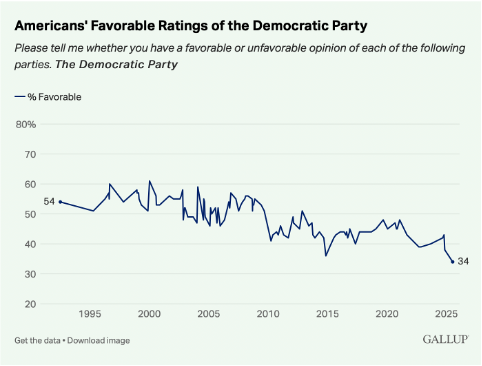
“Democrats have been hoping that a voter backlash against the president will be powerful enough to restore their majority in the House in next year’s midterm elections,” writes Aaron Zitner of The Wall Street Journal. “But the Journal poll shows that the party hasn’t yet accomplished a needed first step in that plan: persuading voters they can do a better job than Trump’s party.”
A recent analysis of state-by-state party registrations drives home the consequence. “Of the 30 states that track voter registration by political party,” Shane Goldmacher and Jonah Smith write, “Democrats lost ground to Republicans in every single one between the 2020 and 2024 elections — and often by a lot.”
All of these data add up to one very big red flag. As G. Elliott Morris put it:
…Democrats are not winning the game of ideas, they’re just winning over a small number of marginal voters who are upset with the party in control of the White House. That’s the typical thermostatic midterm backlash, where voters turn the electoral dial away from the president. Any gains made while the Democratic party’s own image and competency ratings are under water . . . are likely to be weak, motivated by anti-Trump sentiment and thus (in theory) not very long lasting. . .
Most troubling, the party’s leadership is largely ignoring the deeper problems with the Democratic brand lurking behind these numbers. As David Brooks points out on PBS’s Brooks and Capehart:
All my Democratic friends are mad at the party leadership: “We need a message. We need a policy.” But to me, that's too small. Sometimes, historical epochs change, and parties have to change to deal with it. This is a populist epoch. And there's a left-wing version and a right-wing version. But if the Democrats continue along the Clinton-Obama-Biden road, that's just not up to the moment. And so I think it takes a big rethinking, a new identity, a new grand narrative, a new definition of what the biggest problem in the world right now is. And those are all beyond the scope of working politicians who are trying to fund-raise.
If ever there was a time when the Democratic Party needed a big rethink, a new identity, a new grand narrative, a definition of the biggest problem in the world right now—and how to solve it—it is now.
And yet the Democratic National Committee meeting in August did little, if anything, to inspire confidence in the party’s ability to engage in such a rethink, or to do it quickly enough to muster the fortitude to defeat an authoritarian administration seizing more and more power by the day.
Adam Jentleson, former chief of staff to Pennsylvania Sen. John Fetterman, put it most starkly in a phone interview with Lauren Egan: “The DNC is making itself a counterproductive force to winning elections. It would probably be better for the party as a whole if it just turned the lights off and padlocked the building for the next two years.” If, in fact, that’s the case, then perhaps it’s time we build something new.
Building a party that can fight for the 60%+
“This country needs an opposition party that can stand up to an authoritarian movement,” Sarah Longwell told her pals, Tim Miller and J.V. Last, on a recent Next Level podcast:
Right now, do you know how much money the RNC has on hand? 80 million dollars. You know how much the DNC has on hand? 15 million. You know why?
Because people think the party is a joke. A joke. I've been talking to people, and you know what I heard from Democrats? “I can't watch anything. I can't look at anything. It's all so stupid.” They're tapping out, guys. This is why I like what Newsom's doing. He’s at least bringing people back to engage, because people want to feel like they're on a side that could actually do something, that could actually win.
People look at what's happening at the DNC, and they think, “This is stupid. It's so stupid and these people aren't going to lead us to anything but ruin.” And it's an embarrassment. They're embarrassed to be associated with it. They're not going to give us money, and they're not going to line up to run as candidates.
I think donors should get together and be like, “We're building a new thing.” Forget the DNC. That's Ken Martin. Forget it. They can't do anything. Let's build something new that actually fights.4
When Longwell says she’s been talking with people, she means a lot of people. She has conducted hundreds of hours of focus groups all across the country: Democrats, Republicans, Independents. And unlike poll data, Longwell’s focus groups give us insight into why the Democrats are in free fall.
But it’s not just the Democratic Party.
Most Americans think both parties are doing such a poor job that a major new party is needed. According to a 2024 Gallup poll, that number has risen from 40% to 58% over the past 20 years, reaching as high as 63% in 2023. The 2024 result included 69% of independents, 53% of Democrats’ (up from 46% in 2023) and 48% of Republicans (down from 58% in 2023 since MAGA’s rise).
Behind all the numbers in this post — the 2024 election results, the low favorability ratings, the drop in party registrations, the widespread support for a new major party — lies a huge shift in the psychology of the public. In a recent Strength in Numbers post, Morris said of this shift: “A deep sense of frustration with politics is leading to a systematic shedding of major-party political identities in voters’ psyches.” This shedding of identities has huge implications.
As party identities weaken, we have a not-to-be-missed opportunity to build — not a minor third-party sideshow — but a major new party, a powerful coalition party that takes the best from both parties before there is nothing left to take from either.
Let’s face it: Both parties are dead; it’s organ-harvest time.
A grim thought, I know. But some solace lies in recalling that this is not the first time our party system has coded, only for a powerful new party to be born. In the early 1850s, when the Democratic Party was the nation’s pro-slavery party, the growing anti-slavery movement increasingly looked to a divided Whig Party to carry its banner much like today’s anti-authoritarian movement is looking to a divided Democratic Party now. Then, when Congress passed the Kansas-Nebraska Act in 1854, revoking the 1820 Missouri Compromise, the already fractured Whig Party split apart, and chaos ensued as the more peripheral Free Soil Party took up the anti-slavery cause to protect the jobs of white men, and the Protestant-led Know-Nothing Party took up the anti-immigration cause in earnest to keep Catholics out.
In the midst of this political chaos, a relatively unknown Whig politician denounced the MAGA-like Know-Nothing Party in an 1855 letter to a friend:
Our progress in degeneracy appears to me pretty rapid. As a nation, we began by declaring that "all men are created equal." We now practically read it, "all men are created equal, except negroes." When the Know-Nothings get control, it will read "all men are created equal, except negroes, and foreigners, and Catholics." When it comes to this I should prefer emigrating to some country where they make no pretence of loving liberty -- to Russia, for example, where despotism can be taken pure and without the base alloy of hypocrisy.5
That politician was Abraham Lincoln, who along with other Whigs, left his dying party to join the recently launched Republican Party after Congress put the future of slavery and our nation into play with the Kansas-Nebraska Act.6 A number of Democrats — though vehemently opposed to the Whigs’ policies on tariffs, infrastructure spending, and national banking — soon joined them. In a 2018 Politico article, Joshua Zeitz recounts how:
[Many] former Democrats came to look back with disgust on the ways by which Southern Democrats had enforced rigid, doctrinaire support for slavery for decades. Starting in the 1830s, when Congress instituted a “gag rule” barring debate or discussion of the peculiar institution, the Democratic majority blithely tramped over the First Amendment rights of white Northern congressmen in the defense of chattel slavery.
In joining forces, Zeitz explains, Democrats and Whigs could agree on two things:
That slavery must not be extended into the territories, and that the Democratic Party was a dangerous, anti-democratic institution that must be ground out throughout the North. That left much room for disagreement and compromise over the tariff, monetary policy and the powers of the federal state.
By 1860, this new coalition party had picked Lincoln, an untested politician with a flair for narrative and a love of debate, to run as their presidential candidate in hopes of saving our democratic union.
From this history we can extract four lessons that transcend the vast differences in circumstances between then and now:
Lesson 1: It was the dramatic weakening of political parties and identities that opened up the political space needed for a major new party to emerge.
Lesson 2: While Lincoln’s meteoric rise is attributable to many factors — his political savvy, love of debate, gift for story-telling — someone that talented might never have risen so quickly to the top of an established party fighting for its life. Such organizations tend to circle the wagons, pushing out anyone or anything that deviates from the established norm, including excellence.
Lesson 3: Political parties—and the political systems upon which they rest—evolve, shift, and change in response to outside pressures and internal fractures, with political systems shaping the way political parties behave and the behavior of political parties shaping larger political systems. This circular dynamic can be disrupted — say, by destroying parties and dismantling systems, as Trump and MAGA show. But as the birth of the Republican Party shows, only a party that attracts and lifts up exceptional talent can transform them for the better.
Lesson 4: Right now, the duopoly that has governed our politics since the Civil War is struggling mightily to meet the exacting demands of the 21st century: climate change, massive migration, economic dislocation, technological advances and threats, deepening inequality—all of it creating conditions conducive to the rise of authoritarianism around the world. The internal tumult roiling both parties today reflects their inability to meet this moment just as the political parties in the 1850s were unable to meet the moment when slavery’s future was once again put into play. This inability of our parties to address the biggest problems facing us today creates an opportunity to do something we have not done since the Civil War: build a major new party that can.
The Republican party of Lincoln and Reagan is no longer recognizable. Trump and MAGA killed it, and if we let them, they will kill our democracy. Similarly, the Democratic Party of FDR’s New Deal and Johnson’s Great Society is no longer recognizable to those who believed in it. While Democratic pundits and leaders wonder why more and more working families, people of color, Latinos, and young men are abandoning the Democratic Party, they are wondering why the Democratic Party abandoned them.
Today, leaders with extraordinary courage and ability among homeless Republicans, restless Independents, frustrated Democrats, and pragmatic progressives are best off turning their collective energies, not to resuscitating parties kept alive on life support, but to launching a new coalition party that seeks to understand the needs, hopes, worries, and dreams of 60+% of Americans and can speak from the heart with honesty about what we must do to address them.
To build a major new party, and not just a sideshow to a sideshow, this coalition must be as fierce about preserving the integrity of our republic and the strength of our democracy as early Republicans were about preserving our union and dismantling the slave power undercutting our democracy then.
The big question is whether it is possible to take the best from the Democratic and Republican parties, and invent a party that supplants the old and meets the moment better than either of them can — or ever did.
It would undoubtedly be a heavy lift. While the Republican Party is already dead except for its name, the Democratic Party remains an established, if wounded, party with all the vested interests and invested capital long-established entities accrue.
So perhaps a more useful question might be: How can a coalition of courageous, capable leaders across sectors go about creating a successful major new party?
Harnessing the power of skunk works
Inertia is a powerful force. It can pull the best and brightest organizations down toward a mean that is mediocre at best and dysfunctional at worst. To get around inertia, people with imagination have long sought creative ways to bypass or counter its effects.
In World War II, when Germany created the world’s first jet fighter, the Messerschmitt Me 262, the U.S. army responded by asking Lockheed to develop a jet that could best the Messerschmitt. To get it done and get it done quickly, Lockheed turned to engineer Clarence “Kelly” Johnson, whose first move was to select a team of Lockheed’s best engineers and then separate them from the rest of the company. In just 143 days, Johnson’s team designed and built the first version of the XP-80 Shooting Star, while working in secret in a rented circus tent.
What made this revolutionary breakthrough possible was the creation of what came to be called a “skunk works.” The team appropriated the term from the old Lil’ Abner comic strip, which featured a hidden place deep in the woods called “Skonk Works,” where a strong alcoholic beverage was secretly brewed. Over time, “Skonk Works” turned into “Skunk Works,” and over more time and even greater success, skunk works turned into a registered trademark of Lockheed-Martin with a separate facility displaying its own skunk-based logo.
And that, in short, is how you go from a little, unknown team working in a circus tent to an established facility in a major corporation with your own registered trademark and logo.
Now imagine what might happen if a coalition of savvy, determined, entrepreneurial leaders across sectors and the political spectrum met regularly deep in the woods to design in record time the outlines of a new party. Instead of fighting fascism in Germany by building a faster jet, this skunk works would be fighting the rise of fascism in the United States by conceiving a party that turns an abstraction like democracy into a concrete reality people want to vote for — something like:
Un-rigging the rigged system
that put necessities out of reach, divided Americans, and made authoritarianism look good.
A fair system would do things that bolster rather than assault the democratic principles upon which freedom and equality depend — for example, things like:
Making necessities like food, housing, education, energy, and healthcare affordable; creating jobs that ensure a living wage; giving our kids an excellent education and keeping them safe; protecting future generations by working down our national deficit and by investing in the technological and political innovations that would slow or reverse climate change; building community-based civic centers that bring people together to work on common problems; making it possible and attractive for high school graduates to do a year of national service; rebuilding the military capabilities and alliances needed to defend and strengthen democracies around the world; protecting our borders and people’s rights; fostering a fair and competitive economic system (e.g., lowering taxes for the 90+%; closing the loopholes unfairly benefitting the top 1%; promoting a competitive marketplace); ensuring a just, democratic political system (e.g., getting money out of politics; putting a stop to gerrymandering, protecting voting rights, upholding the rule of law). Et cetera . . .
Who knows what a new party, once unleashed, might think of? The design work would, of course, be formidable, requiring a “big rethinking,” as Brooks put it. It would have to:
Move from sorting and slotting voters into demographic categories to figuring out the cross-cutting needs of 60+% of Americans.
Talk with, listen to, and learn from voting and non-voting citizens about what they most need and how those needs might be met.
Treat citizens like partners, not consumers, creating a relationship of give-and-take that goes beyond money.
Give people three simple reasons why they should vote for them, not just against the other guy;
Put any policy ideas in the context of “a new identity, a new grand narrative, a definition of the biggest problem in the world right now—and how to solve it.”
Invent new ways of reaching the 60% + of Americans yearning for a party they want to vote for, not just against, a party with leaders who are direct, courageous, and fight-worthy.
Reimagine campaigning — say, for example, by turning campaign headquarters into local party chapters that understand community needs and partner with communities to see that they get met.
Engineer a daring “Great Escape” from the political captivity in which big-money, special interests hold political parties.
Entice enough established heavy-hitters to join — or at the very least, motivate them not to resist.
Wanted: Fighters to save our democratic republic
To defeat authoritarianism, we need leaders among homeless Republicans, restless Independents, frustrated Democrats, and pragmatic progressives to band together and build a party that, above all else, can fight. This new party will need to inspire and attract a lot of fighters on the ground, fighters with the courage and ability to march through walls and play well together. To name just a very few, people like (click on the links to check them out):
Service-oriented leaders like Texas Representative James Talarico who is calling on us to follow Christ’s example by flipping tables in the halls of power, and Denver Mayor Mike Johnston, whose response to immigration in Denver is redefining our immigration debates.
Former Republican Representative Adam Kinzinger, who served on the January 6th Committee, and shortly after, retired from Congress to launch Country First, mobilizing citizens to resist Trump’s continued efforts to overthrow our republic and establish an authoritarian regime.
Principled fighters like Democratic N.J. Rep. Corey Booker, who drew on John Lewis’s words in his marathon floor speech to ask Americans to “get in good trouble” to redeem the soul of America, and Democratic Senator from California, Alex Padilla, who, after getting forcibly removed from a DHS meeting, gave a floor speech calling on Congress and the American people to speak out against Trump’s abuse of power.
Self-described paycheck populist, Dan Osborn, an independent who established a PAC to support working-class candidates, led a successful 77-day strike against Kellogg, and got 47% of the vote in the 2024 Nebraska U.S. Senate election, an unheard of showing for an independent.
Pragmatic progressives like Bernie Sanders who, at 83-years-old, still has fire in his belly for our democracy and for working people of all colors; and Lucas Kunce, who got an impressive 42% of the vote in Trump counties in his 2024 Missouri Senate race against Josh Hawley. Throughout his campaign, Lucas listened to and learned from the people he hoped to represent and serve, and he captured those learnings in a post-action report in his Substack newsletter.
Upstart candidates like Christian Urrutia from New Hampshire or Nathan Sage from Iowa, who are rejecting their party’s cautious mindset and campaign orthodoxy to go after MAGA candidates;
Iowa Democrat Caitlin Drey who, in giving people three simple reasons to vote for her (not just against her opponent) won by 10 points in a 20 point + Trump district, breaking the state’s Republican supermajority.
Young leaders like 28-year-old Florida Representative Maxwell Frost who is organizing year-round to get to know the folks in his district, while reaching out to those we’re losing by doing things like giving iShowSpeed a tour of the U.S. Capitol, to which 150,000 young folks tuned in, most of them young men.
There is a lot of fight-worthy talent out there with the courage and ability to defeat authoritarianism and rebuild our democracy on firmer, fairer ground.
But they can’t do it with one hand tied behind their backs, tethered to a party that has lost the confidence of the people they most need. Nor can they do it alone. They need leaders from all walks of life — politics, business, philanthropy, faith groups, community groups, nonprofits, veteran groups, public service — to band together and build a broad-coalition party that can bolster their courage, support their risk-taking, and have their backs when they enter the ring.
“As our case is new,” Lincoln said at a time much like our own, “we must think anew and act anew.”
Retreat at your own risk
Authoritarianism is overtaking what was once a city on an impregnable hill. We need a party that can defeat today’s authoritarian movement just like the XP-80 Shooting Star helped overcome fascist Germany by besting the Messerschmitt Me 262.
This is no time to retreat and say it can’t be done.
It is a time to lean in, come together, and figure out how to do it.
Don’t like this idea? Great! Let’s hear yours, or any thoughts you have on how to improve this one.
Footnotes
More in Common’s 2018 research discovered that 67% of Americans, exhausted by political polarization, are more flexible and pragmatic than the more ideological wings on the left and right. We need to recruit this all-but-invisible majority, ignored by most media and politicians, before they slip away into political oblivion or extremism. Impossible? See the preface to Remaking the Space Between Us.
The below poll, cited in the Substack newsletter Strength in Numbers, is just one of several noting a widespread desire for systemic change. See, for example, Pew’s 2024 poll
Lindsay Ellis and Aaron Zitner, “Americans Lose Faith That Hard Work Lead to Economic Gains, WSJ-NORC Poll Finds,” The Wall Street Journal, September 1, 2025, and Inti Pacheco and Theo Francis, “What We Know About America’s Billionaires: 1,135 and Counting,” The Wall Street Journal, September 2, 2025. Nick Hanauer, “The Top 1% of Americans Have Taken $50 Trillion From the Bottom 90%—And That’s Made the U.S. Less Secure,” Time, September 14, 2020.
I slightly edited Sarah’s remarks for clarity and brevity.
Letter to Joshua Speed.
For instructive accounts of the Republican party’s beginnings, see https://www.ebsco.com/research-starters/history/birth-republican-party and Joshua Zeitz, “Never Trumpers Will Want to Read This History Lesson” The similarities between the two times have much to teach us, as do the differences.




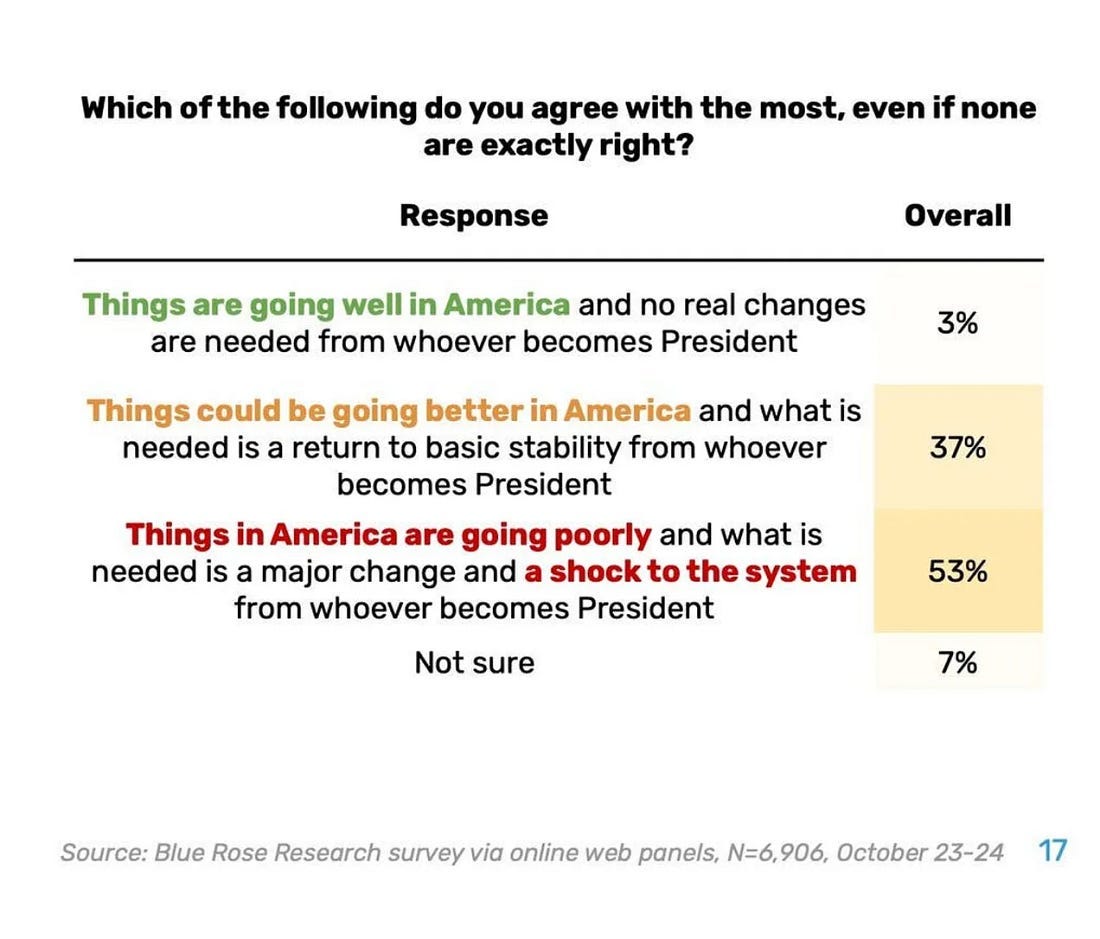
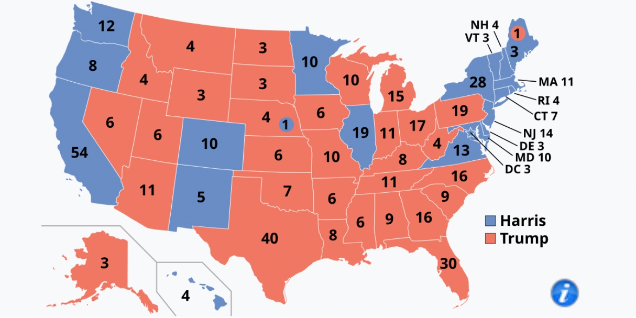
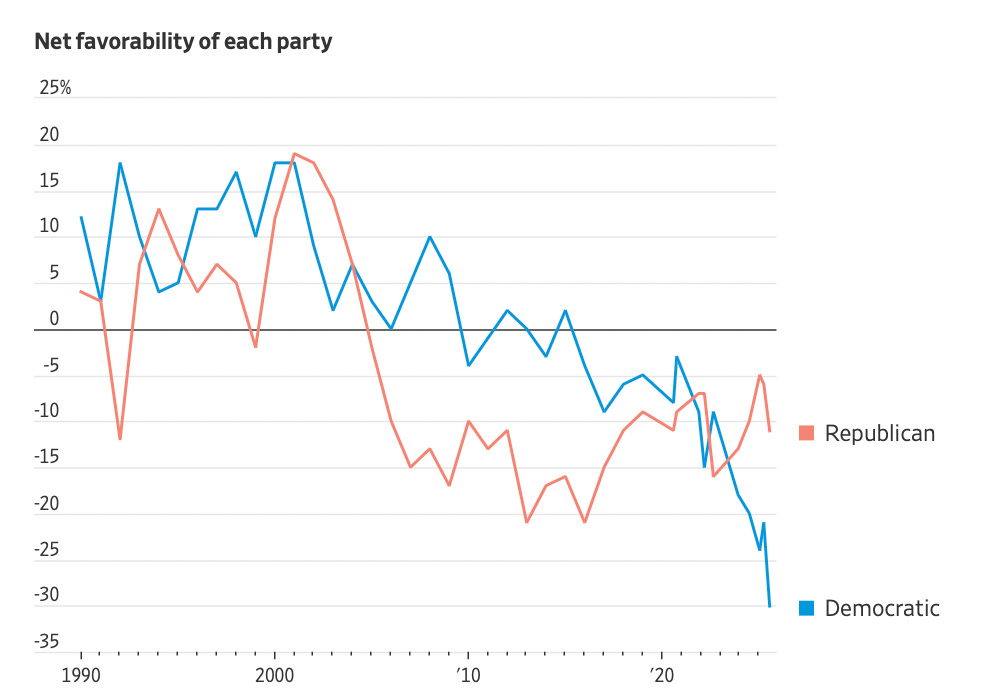
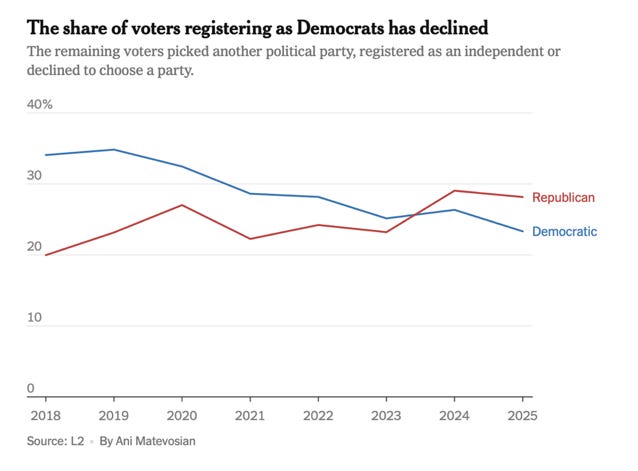
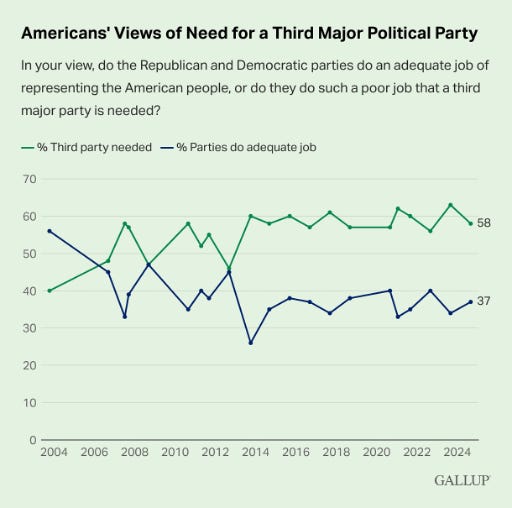
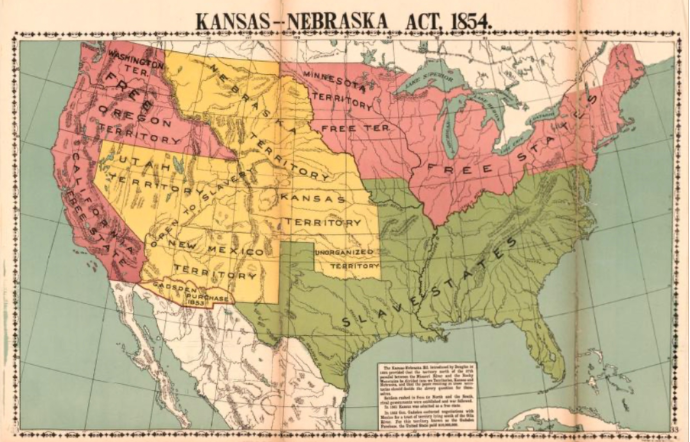

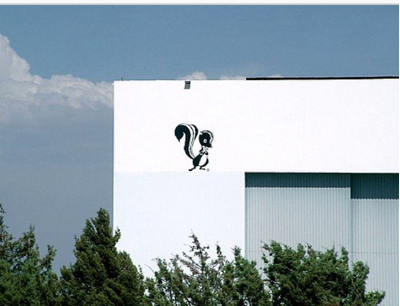

Diana- I love the analogy that you use between “body politik” and ER. It definitely illustrates the case you’re making and puts a visual on all your insights. I appreciate this.
Thank you for such an incredibly thoughtful, well researched article, Diana. I hope this gets wide distribution.
And rather than waiting for a new party to emerge, all of us can demand that our elected officials engage with ordinary community members, remove the extraordinary influence of large donors, and reflect the core values that have always helped so many in times when the United States failed to live up to its promise. We can support an independent judiciary, insist on the limited roles for military and policing, and do our own part in building relationships across boundaries within our schools, our religious institutions, our neighborhoods.